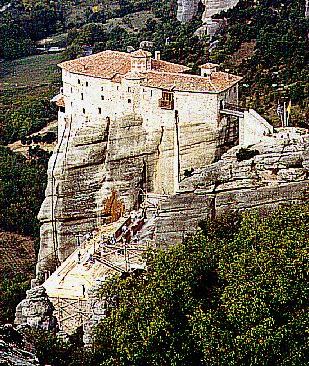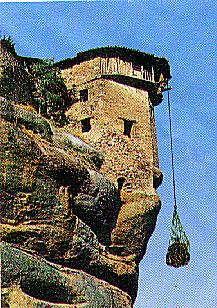 | Paul went from Beroea to Athens by ship (Acts 17:14), but we went overland by bus. Our first stop was Kalambaka, a town near the Monasteries of Meteora. The next morning we visited two of the five remaining monasteries, all of which are perched on top of high sheer cliffs. As the tourist brochure says, "The Meteora monasteries rise at the center of Greece, where the Pinios river emerges from the deep canyons of the Pindus range and surges into the Thessalian plain. These are gigantic rocks etched by time into a variety of shapes; grey stalagmites rising towards the sky, they appear as nature's gift to the pious who, driven by faith, have opted for solitude and a life of worship." | |
| "The Monasteries, with their wooden galleries and cornice rooftops, crown the summits of these formidable pinnacles. Precariously hanging over the sinister abysses, with the Pindus range at their back and the vast plain, woods, gorges and picturesque villages below, these unworldly hermitages compose one of the most breathtaking sites on earth." The views are spectacular and make you wonder how the first monks scaled the cliffs to construct the first buildings. |  | |
 | Hermits began settling here in the 9th century and the monastic community movement began in the 11th, reaching its peak in the 15th and 16th centuries. The convent we visited, St. Stevens, built in the early 1300s, began as a monastery and only recently became a convent. It is connected to the main cliff by a bridge over a steep gorge. The Monastery of Varlaam, built in 1517, is reached by climbing 195 steps. It still has a rope and pulley system in place that was once used for hoisting visitors by hand in a free swinging rope net. Today the net is used only for supplies and a motorized winch has replaced the hand crank. The frescoes in the chapel of All Saints were painted in 1548. | |
To Delphi 




